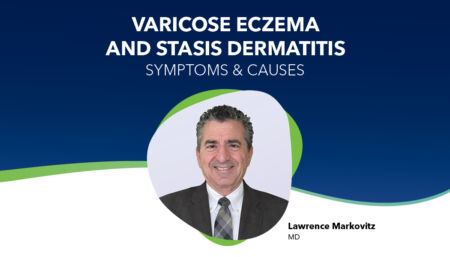
Medically reviewed by Lawrence Markovitz, MD, on July 18, 2023
Essentially the same condition, varicose eczema, and stasis dermatitis are different names used to describe the same skin disorder.
Lawrence Markovitz, MD, FACS, is the lead vein physician at Center for Vein Restoration clinics located in McLean, Virginia, and Purcellville, Virginia. He is a board-certified thoracic surgeon with decades of experience in cardiac and thoracic surgery. In 2008 he turned his professional focus to diagnosing and treating venous disorders.
Venous stasis dermatitis, also referred to as varicose eczema, is a kind of skin disorder that can occur in people who also have varicose veins. Caused by underlying venous insufficiency, varicose veins are large, twisted, bulging veins that lie just below the surface of the skin that commonly appear in the legs and feet.
Stasis dermatitis can happen when blood is prevented from moving efficiently through your body. This allows water and blood cells to build up, resulting in blood leaking out of the veins and into the skin. It causes inflammation, ulcers, and itchiness on the skin of the lower legs.
People over 70 who struggle with varicose veins or deep vein thrombosis or who have had varicose vein surgery in the past have the highest risk of developing venous stasis dermatitis. It is also more likely to occur in women.
Early varicose eczema symptoms may include:
If left untreated, severe venous eczema can lead to ulcers, which are much more difficult to treat and heal. Severe stasis dermatitis can result in permanent changes to your skin, including thickening, hardening, darkening, or a bumpy, cobblestone-like appearance.
Varicose eczema is usually caused by increased blood pressure in the veins due to damaged vein valves (tiny flaps inside the veins that help push blood back toward the heart). When your circulation isn't as effective as it should be, your veins don't return blood to your heart as they're supposed to.
Age and certain health issues can cause your vein valves not to work normally, known as venous insufficiency. As pressure increases, the damaged vein can leak fluid and blood under the skin and cause inflammation and then eczema. Other risk factors making venous stasis dermatitis more likely include:
The key to effective varicose eczema treatment is keeping the skin moisturized. Common treatment options include:
Self-help techniques
Avoid worsening eczema symptoms with these tips:
Emollients
Apply a moisturizing ointment, cream, or lotion to the skin to help reduce water loss. You may also cover it with a protective layer or bandage to help manage dry or scaly skin. Talk to your doctor to determine which type of emollient is right for you.
Topical corticosteroids
Your doctor may prescribe a topical steroid to ease the itching, flaking, oozing, and redness often associated with venous eczema. They are available in many different strengths, so talk to your doctor to determine which is right for you.
Compression stockings
Medical compression stockings are specially designed to gently and steadily squeeze your legs to improve circulation, encouraging blood to flow upward toward your heart. Venous ulcers can be treated with compresses and bland dressings such as zinc oxide paste. A zinc gelatin treatment known as an Unna paste boot can be used in ambulatory patients.
While no cure exists for stasis dermatitis, early treatment, and certain preventative measures can keep the condition from worsening. At Center for Vein Restoration (CVR), we specialize in a range of minimally invasive, state-of-the-art varicose vein treatment options. Visit a CVR location near you to speak to one of our skilled vein care specialists about effectively managing varicose eczema symptoms with ongoing self-care and maintenance.
With over 100 Center for Vein Restoration clinic locations across the United States, we make connecting with an experienced vein care specialist near you easy. Simply schedule ONLINE or call 240-965-3915 to speak to a helping Patient Services Representative.
Center for Vein Restoration accepts insurance, including Medicare and Medicaid.